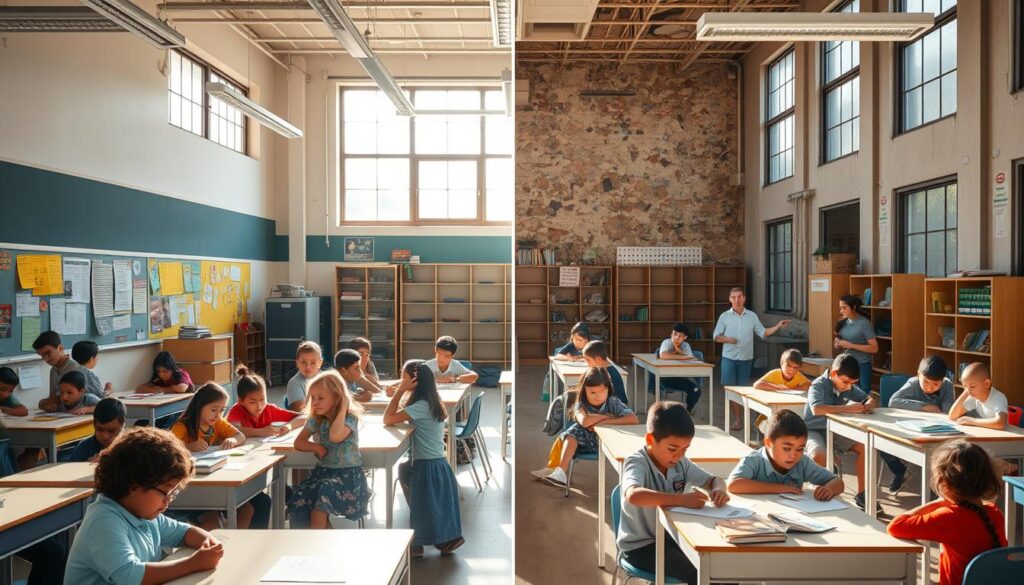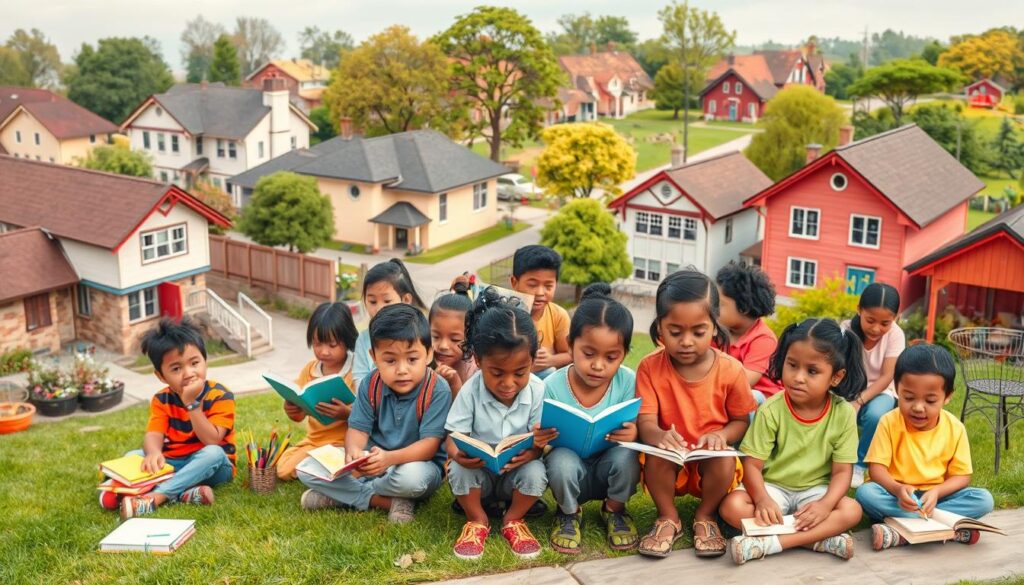In my years of studying education, I’ve found something important. Socioeconomic status greatly affects how well students do in school. There are big differences in what students learn, depending on their background.
Income inequality makes it hard for students from poorer families. The gap in achievement grows because they don’t have the same chances. They can’t get to the same educational resources, tutoring, or help.
My studies show that a student’s economic situation is key to their success in school. Families with less money struggle to give their kids the support they need to do well.
Key Takeaways
- Socioeconomic status directly impacts educational opportunities
- Income inequality creates significant learning barriers
- Economic background influences academic performance
- Students from low-income families face additional educational challenges
- Resource access varies dramatically across economic groups
Understanding the Relationship Between Income and Academic Success
Economic disparities greatly affect students’ education. My research shows that family income is a big factor in how well students do in school. This creates big challenges for many students in the United States.
Key Economic Factors Affecting Student Performance
Students from low-income families face big hurdles in school. These include:
- Limited access to quality educational resources
- Reduced opportunities for academic enrichment
- Higher stress levels related to financial instability
- Decreased likelihood of advanced course participation
Income Inequality’s Role in Educational Disparities
“The zip code of a child can determine their educational destiny.” – Educational Policy Researcher
Income inequality leads to a big gap in school opportunities. Wealthy school districts have:
- Advanced technology in classrooms
- Specialized academic programs
- Higher-quality instructional materials
- Better-trained teaching staff
The Hidden Costs of Education
Students from low-income families face more than just tuition costs. Textbooks, technology, extracurricular activities, and tutoring are big expenses. These costs can really affect how well students do in school.
These financial hurdles make it hard for students to overcome their economic challenges. It’s tough for them to reach their full educational and career goals.
The Effects of Socioeconomic Status on Educational Outcomes
Socioeconomic status greatly affects how well students do in school in the United States. My research shows how money can impact grades and chances to move up in society. Kids from poorer families often face big hurdles that block their path to learning.
“Economic background is not destiny, but it undeniably influences a student’s academic trajectory.” – Educational Research Institute
The link between money and school success is deep and complex. Several things affect how well a student does in school, including:
- Access to educational resources
- Quality of early childhood education
- Parental educational background
- Financial capacity for additional learning support
I’ve looked at a lot of data that shows big gaps in school success based on family income. Here are some numbers that show these gaps:
| Socioeconomic Level | High School Graduation Rate | College Enrollment |
|---|---|---|
| Low-Income Families | 68% | 40% |
| High-Income Families | 91% | 80% |
These numbers show why we need to work hard to help everyone have a fair shot at school. Educational equity means we need to support students from all walks of life. While it’s tough, we can make a difference with the right help.
Knowing how money affects school is the first step to making things better in our schools.
How School Funding Shapes Learning Opportunities
School funding is key to educational quality and student success. How resources are spread out can greatly affect a student’s learning and goals.

I’ve seen how uneven school funding hurts students in different areas. The achievement gap often comes from money and resource differences.
Resource Distribution Across School Districts
School funding varies a lot between districts, affecting learning chances. Big differences include:
- Classroom technology access
- Quality of instructional materials
- Teacher training and professional development
- Extracurricular program availability
Technology Access and Digital Divide
The digital divide is a big problem in education. Students in poor districts often miss out on key tech for learning.
| District Type | Average Technology Budget | Student Device Ratio |
|---|---|---|
| High-Income Districts | $250,000 | 1:1 devices |
| Low-Income Districts | $50,000 | 1:5 devices |
Impact of Educational Programs and Support Services
Investing in support services can help close the achievement gap. Programs that cover all aspects of a student’s life make learning fairer.
“Educational funding is not just about money, but about creating opportunities for every student to succeed.” – Education Policy Expert
By focusing on fair school funding and resource sharing, we can change education. This way, we can give real chances to all students.
Parental Education and Student Achievement

Parental education levels are key in shaping a child’s academic success and social mobility chances. Studies show that parents with higher education create better learning environments for their kids.
The links between parental education and student success are complex:
- Parents with advanced degrees offer more educational resources
- Higher education in parents means stronger academic goals
- Educated parents know better ways to help with learning
Understanding these dynamics helps us see the complex nature of educational inequality. Kids of college-educated parents usually have:
- More access to educational materials
- Consistent academic advice
- Higher motivation to do well in school
“Education is the most powerful weapon which you can use to change the world.” – Nelson Mandela
To break cycles of limited education, we need specific actions. Community programs, mentorship, and scholarships can help students from less educated backgrounds.
When we tackle these educational challenges, social mobility becomes more possible.
Neighborhood Effects and Academic Performance
Neighborhoods greatly affect students’ education. The area around a student can change their academic path. This creates big challenges with educational resources and income.

Different neighborhoods offer different chances for learning. Students in poor areas face big hurdles to succeed in school.
Community Resources and Educational Support
Community resources can greatly help a student’s learning. Local libraries, community centers, and after-school programs are key. They help close the gap caused by income differences.
- Access to quality tutoring services
- Free educational workshops
- Community mentorship programs
- Technology centers with learning resources
Social Network Impact on Academic Goals
A student’s friends can greatly influence their goals. Neighborhood effects show that friends and local heroes shape what students aim for in school.
“Your environment is the invisible hand that shapes human behavior.” – James Clear
Access to Quality Schools in Different Areas
School quality changes a lot in different neighborhoods. This creates big differences in what schools offer. Families with more money can pick better schools.
| Neighborhood Type | Average School Rating | Student Performance |
|---|---|---|
| High-Income Areas | 8.5/10 | Advanced |
| Middle-Income Areas | 6.5/10 | Moderate |
| Low-Income Areas | 4.2/10 | Below Average |
It’s key to know these neighborhood facts. We need to create special education plans to help all students.
Conclusion
My research shows a clear problem in the U.S. education system. The achievement gap is huge, making it hard for students from poor families. Social mobility seems out of reach for many families stuck in poverty.
The link between money, community resources, and school success is complex. We need more than just money to fix this. Schools, leaders, and communities must work together. They need to create support systems that help all students, no matter their family’s income.
There’s hope, though. New educational programs and more money for poor schools can help. By understanding how money affects school success, we can make education fairer. This way, we can help students succeed and move up in society.
Education is key to changing lives and overcoming poverty. My study highlights the need for more research and effort. We must make sure our schools serve all students, no matter where they start.



